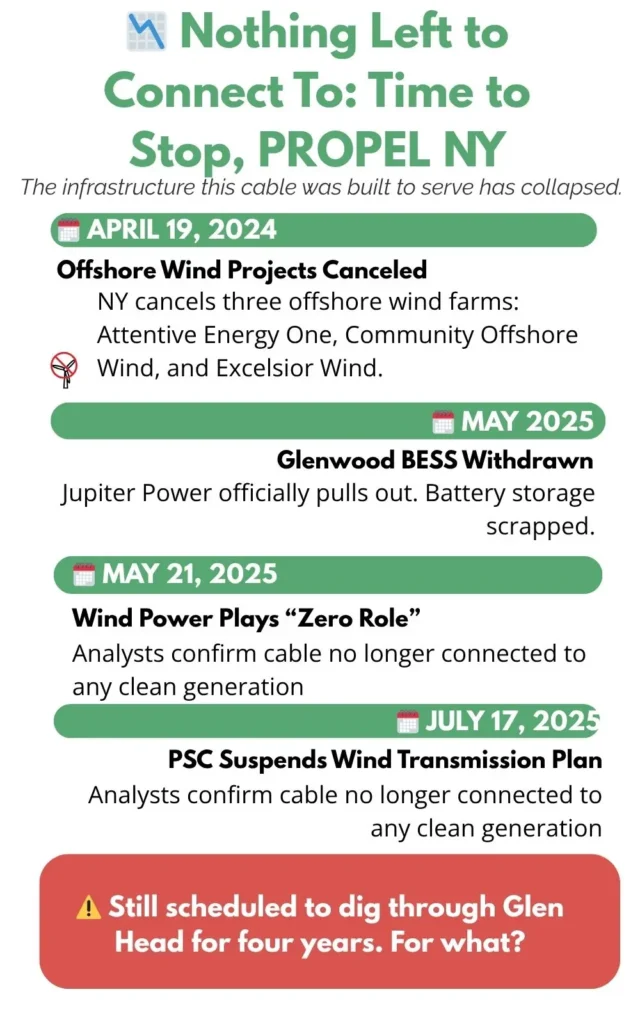The PROPEL NY project has no place in Glen Head — and nothing left to connect to.
Introduction
Last night, I stood in front of a packed room at the Glen Cove American Legion and said what so many in our community are thinking: we don’t want the PROPEL NY cable project here. As the Queen Bee of the eco-friendly business Backyard Bees and as an environmentally conscious individual, I felt it was necessary to add my voice to my neighbors’ collective concerns.
Ironically, I didn’t speak to the environmental issues surrounding this so-called “green energy solution.” Instead, I focused on the absurdity of moving forward with a massive infrastructure project when the endpoints have both been canceled. The offshore wind turbines and the Battery Energy Storage Systems (BESS) that the cables were supposed to connect to? Scrapped. So…I asked the question on everyone’s mind: Why are we even here?
My appearance was featured on Channel 12 Long Island News, and I’m glad for the attention. There’s still a lot to say about this absurd excuse for a “green energy” solution. Calling it “clean” doesn’t make it so. What’s being proposed threatens our local environment, disregards community concerns, and undermines what sustainability truly means.
1. The “Green Energy” Fallacy
It’s no accident that PROPEL NY leans heavily on the idea of “green energy” to sell this project. Their blue and green logo colors are probably designed to make you think of “blue skies, clean water, and green grass,” but honestly, this project would turn Glen Head and the surrounding communities brown, gray, and black: miles of ripped-up roads, noise pollution from machinery needed to dig 10-foot ditches, and the smell of exhaust from both construction equipment and the inevitable standstill traffic… for four years!
The PROPEL NY cable is being sold as part of New York’s green energy future—but the offshore wind projects it was meant to connect to have already been canceled or delayed indefinitely. Even the Battery Energy Storage Systems (BESS) that were supposed to help distribute that power have been scrapped. That means this invasive project now serves no meaningful purpose. And yet, it still moves forward, threatening to tear up our neighborhoods, disrupt ecosystems, and expose our community to unnecessary environmental risks. There is nothing green about that.
This is a classic case of greenwashing—when companies or projects use eco-friendly language and branding to disguise environmental harm. Just because something claims to be “clean” doesn’t mean it actually is. True sustainability considers the full impact—from source to delivery—and respects the people and places in its path.
2. Environmental Impact on Glen Head
The first speaker of the evening represented Friends of Hempstead Harbor; the tone was one of regrettable acceptance of the project, with suggestions for testing and monitoring that could potentially mitigate the damage that would definitely be done to the harbor. Friends of the Harbor have spent decades restoring the water from a polluted wasteland to a thriving ecosystem—where oysters thrive and people swim and kayak. It took years to recover from industrial waste and lack of oversight. Why would we risk reversing that progress now?
The health implications of the EMFs (electromagnetic fields) emitted from the cables are another major concern for our small community. There are no long-term studies on EMFs at this intensity. Studies on current EMF levels from cell towers indicate an increased risk of childhood leukemia. And yet, somehow no one wants to talk about the fact that these high-voltage cables will run right past our homes and businesses. According to one speaker, the high-voltage cables proposed here would emit 17 times more EMFs than those from standard cell towers.
3. Community Concerns Ignored
“No one asked us what we want.” Several people said that. And it’s true—we sure don’t want this. There were over 200 people at the morning session, and the room was similarly full in the evening. Our voices were loud and clear, and words like “ludicrous,” “insanity,” and “perplexing” were echoed again and again.
This $3.26 billion project is projected to upend our small town for four years… and connect to nothing.
Even Nassau County Legislator Delia DeRiggi-Whitton spoke out against it.
“Everyone loves the idea of green energy, but the transparency here is sorely lacking. It has been incredibly difficult to get information.”
Why did we even need to be there at all? This should be a no-brainer. And yet, we all sit at home holding our breath until the project is canceled.
4. As a Green Business Owner, I Can’t Stay Silent
For over 15 years, I’ve run a business rooted in environmental responsibility—from the products we use to the packaging we avoid, every decision is made with the planet in mind. I don’t just talk about sustainability; I live it.
That’s why I find it so frustrating—and frankly offensive—when massive infrastructure projects like PROPEL NY are branded as “green” just because they once involved offshore wind.
True sustainability isn’t just about where energy comes from; it’s about how it’s delivered, who it impacts, and whether it honors the environment and community every step of the way. This project would tear through our neighborhoods, damage ecosystems, and leave behind consequences that no glossy PR campaign can sweep under the rug.

5. Cleaner, Smarter Alternatives Exist
Cleaner energy options are important to me—but they must be pursued responsibly, transparently, and with community input. There are smarter, less destructive ways to move toward sustainability. Decentralized rooftop solar, community microgrids, and local conservation programs can reduce strain on the grid without tearing up 100 miles of roads or endangering neighborhoods.
Imagine if even a fraction of the $3.26 billion earmarked for PROPEL NY went toward helping homeowners install solar panels, improving energy efficiency in schools, or upgrading the grid in ways that don’t involve burying high-voltage cables under residential streets. (Streets without sidewalks or shoulders, meaning these cables are literally on the doorsteps of our homes and businesses.) This project is not the only option—it’s just the most disruptive one.
6. This Fight Isn’t Over
The packed hearing room made one thing clear: our community is awake, aware, and not ready to give up. From Glen Head to Sea Cliff to Glen Cove, residents are standing up, speaking out, and organizing. This isn’t NIMBYism—it’s common sense. We are not a sacrifice zone for a project that no longer makes sense.
If you haven’t already, contact your local elected officials. Share information with neighbors. Stay connected on community Facebook pages and mailing lists. And demand that the agencies reviewing this project take a long, hard look at what we’re really being asked to give up—and what we’re no longer getting in return.
Conclusion
The PROPEL NY project is being sold as a step toward sustainability—but it’s built on outdated plans and broken promises. The offshore wind farms are gone. The battery storage units are canceled. What’s left is a $3.26 billion boondoggle that threatens our health, our homes, and the environment we’ve worked so hard to protect.
This isn’t green energy—it’s greenwashing. And we deserve better.
I may be the Queen of Green for Backyard Bees, but I’m also one of many Glen Head residents saying: enough is enough.
This project must be stopped.



